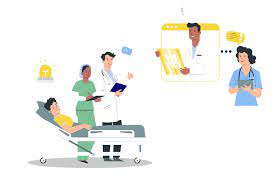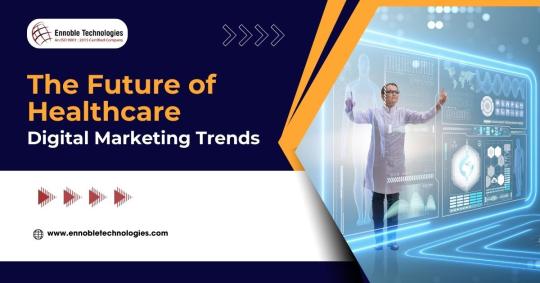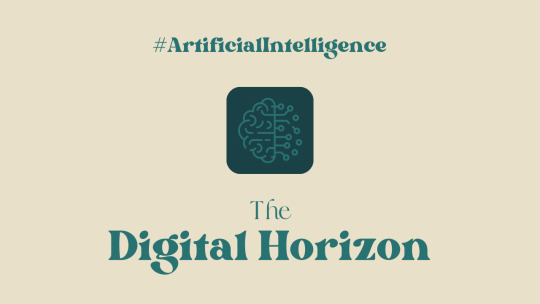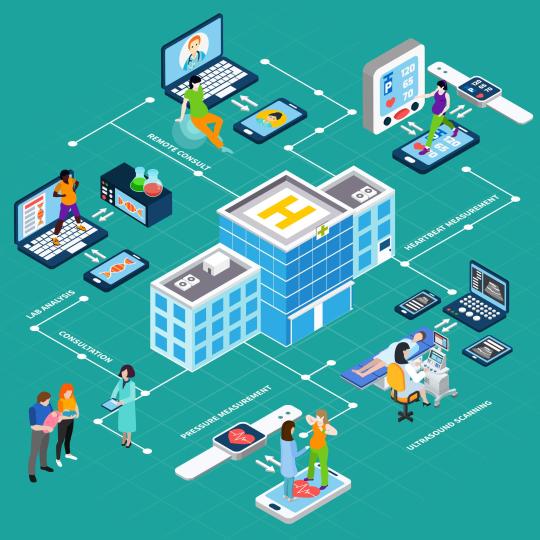#Telemedicine Trends
Text
Telemedicine in Acute Care: Market Dynamics and Growth Prospects
The global acute care telemedicine market is expected to reach USD 60.2 billion by 2030, based on a new report by Grand View Research, Inc. The market is expected to expand at a CAGR of 14.8% from 2022 to 2030. Technological development in the healthcare sector, increasing demand for immediate access to medical care, and shortage of specialty physicians especially in developing countries are some factors driving telemedicine growth in an acute care setting.

Acute Care Telemedicine Market Report Highlights
Based on delivery, the clinician-to-patient segment accounted for the largest market share of 62.5% in 2021 as it provides easy access to medical professionals through chat or video conferencing and reduces long waiting and travel times to get treatment.
The telepsychiatry segment is expected to witness the fastest CAGR of 15.5% over the forecast period. The sector is witnessing significant growth as it holds the potential to become a better option to traditional in-person psychiatric facilities.
Based on the end-use, the hospitals and clinics segment dominated the market with a revenue share of 75.5% and is likely to grow at the fastest growth rate from 2022 to 2030. This is owing to the shortage of specialist physicians, especially in developing countries, and increased demand for better healthcare access among the people.
North America accounted for the largest revenue share of nearly 42.4% in 2021. Due to a favorable reimbursement structure and the availability of telemedicine services. For instance, In January 2021, The American Telemedicine Association (ATA) and the Digital Medicine Society (DiMe) launched “IMPACT” a new program for virtual healthcare.
The Europe market is anticipated to witness rapid growth over the forecast period with a CAGR of 15.2%. The increase in the elderly population and increased development in the healthcare infrastructure is driving the regional market expansion
Gain deeper insights on the market and receive your free copy with TOC now @: Acute Care Telemedicine Market Report
The COVID-19 pandemic caused the healthcare system to encounter various challenges. The swift adoption of various technologies across countries, driven by the necessity to provide continued medical care in the era of social distancing, has increased the penetration of telemedicine in acute care. In addition, the Centers for Medicare & Medicaid Services (CMS) increased the coverage of telehealth services through temporary waivers soon after the declaration of COVID-19 as a public health emergency in early 2020 to make it convenient for people to receive medical care while reducing their exposure to the virus in public settings such as hospitals and health care facilities.
Furthermore, the World Health Organization and the International Telecommunication Union (ITU) collaborated to produce a universal standard for the usage of telehealth services to address the problem on an international scale. This guideline describes the technological criteria that a telehealth platform must fulfill to deliver accessible telehealth services.
In December 2021, Five Ascension Texas facilities collaborated with the nation’s major multispecialty telemedicine group to offer teleneurology services to their patients. The collaboration was intended to ensure 24/7 access to special neurology care. It will also strengthen on-site neurology treatment by offering doctors, nurses, and other professionals high-definition video consultations with neurologists on demand.
#Telemedicine#Acute Care#Health Tech#Virtual Healthcare#Telehealth#Remote Consultation#Medical Technology#Healthcare Innovation#Patient Care#Digital Health#Telemedicine Solutions#Telemedicine Trends#Telemedicine Services#Telemedicine Benefits#Telehealth Platform#Telemedicine Providers#Telemedicine Implementation#Telemedicine Strategy#Telehealth Solutions#Telemedicine Ecosystem
0 notes
Link
As the world rapidly evolves, so does how we approach healthcare. Telemedicine platforms has been on the rise for years, but in 2023, it’s set to take the healthcare industry by storm. From virtual consultations to remote monitoring, the latest telemedicine trends offer countless benefits.
#telemedicine#telemedicine trends#telemedicine trends in healthcare#telemedicine trends in 2023#telemedicineapp#vcdoctor
1 note
·
View note
Link
Mobile healthcare apps are more important than ever in streamlining the workflow of healthcare providers.
Software development for healthcare app like Telemedicine app development solutions, and telehealth app development are some trending solutions in healthcare software development.
#healthcare software development#healthcare app development#healthcare#Healthcare Application Development#healthcare software solutions#Telemedicine#telehealth#Digital Transformation#healthcare technology#technology#healthcare trends#trends
2 notes
·
View notes
Text
Telehealth Solutions: Enhancing Patient Care Remotely

Telehealth, also known as telemedicine, represents a transformative approach to healthcare delivery, leveraging technology to connect patients with healthcare providers remotely. This innovative model of care has gained significant traction in recent years, driven by advances in communication technology and the growing need for accessible, efficient healthcare solutions.
At its core, telehealth encompasses a broad range of services, including virtual consultations, remote monitoring, telepsychiatry, and telepharmacy, among others. Through secure digital platforms, patients can consult with healthcare professionals from the comfort of their homes, eliminating the need for physical visits to medical facilities. This convenience is particularly beneficial for individuals with mobility limitations, those residing in rural or underserved areas, and patients managing chronic conditions.
One of the key advantages of telehealth is its ability to overcome traditional barriers to healthcare access. By leveraging telecommunication tools such as video conferencing, secure messaging, and mobile apps, patients can receive timely medical advice, diagnosis, and treatment regardless of geographical location. This is especially crucial in regions where healthcare infrastructure is limited or where specialist care is scarce, enabling patients to access a broader network of healthcare professionals without the need for travel.
Moreover, telehealth enhances continuity of care by enabling seamless communication between patients and providers. Through remote monitoring devices and wearable technology, healthcare teams can track patients' vital signs, medication adherence, and overall health status in real-time, allowing for early intervention and proactive management of chronic conditions. This proactive approach not only improves patient outcomes but also reduces the burden on emergency departments and hospital admissions.
In addition to its practical benefits, telehealth has demonstrated cost-effectiveness and efficiency in healthcare delivery. By reducing the need for in-person visits and unnecessary hospitalizations, telemedicine lowers healthcare expenditures for both patients and providers. Furthermore, it optimizes resource utilization by streamlining administrative processes, reducing wait times, and maximizing healthcare professionals' productivity.
However, despite its numerous advantages, telehealth also presents challenges, including regulatory hurdles, privacy concerns, and disparities in access to technology. As telehealth continues to evolve, policymakers, healthcare organizations, and technology developers must collaborate to address these challenges and ensure equitable access to high-quality virtual care for all patients.
In conclusion, telehealth holds immense promise in revolutionizing healthcare delivery by leveraging technology to enhance access, efficiency, and quality of care. As society increasingly embraces digital solutions, telemedicine is poised to play an integral role in shaping the future of healthcare, empowering patients, and improving health outcomes worldwide.
#Telehealth/Telemedicine Market Demand#Telehealth/Telemedicine Market Share#Telehealth/Telemedicine Market Trend#Telehealth/Telemedicine Market Size
0 notes
Text
The Future of Virtual Doctor Care: Trends and Predictions

The future of virtual doctor care holds immense promise as technology continues to advance and healthcare delivery undergoes transformational changes. Several trends and predictions are shaping the evolution of virtual doctor care, offering insights into what the future may hold for patients, healthcare providers, and healthcare systems:
Expansion of Telemedicine Services: Telemedicine services will continue to expand and diversify, offering a broader range of healthcare services and specialties through virtual platforms. While telemedicine initially focused on primary care and urgent care services, the future will see the integration of specialty care, behavioral health services, chronic disease management, and preventive care into virtual care models. As technology evolves and regulations evolve to accommodate these changes, patients will have access to a comprehensive array of healthcare services through virtual channels.
Integration of Artificial Intelligence (AI) and Machine Learning: The integration of artificial intelligence (AI) and machine learning technologies will enhance the capabilities of virtual doctor-care platforms, enabling more personalized and predictive healthcare experiences. AI-powered algorithms can analyze patient data, medical histories, and diagnostic images to assist healthcare providers in making accurate diagnoses, recommending treatment options, and predicting patient outcomes. Virtual care platforms will leverage AI-driven chatbots and virtual assistants to enhance patient engagement, provide real-time support, and deliver personalized health information and recommendations.
Adoption of Remote Monitoring and Wearable Devices: Remote monitoring technologies and wearable devices will play an increasingly prominent role in virtual doctor care, enabling continuous monitoring of patients' vital signs, health metrics, and disease markers from the comfort of their homes. Connected devices such as smartwatches, fitness trackers, and medical sensors can collect real-time data and transmit it to healthcare providers for analysis and interpretation. Remote monitoring allows for proactive intervention, early detection of health issues, and personalized treatment adjustments, ultimately improving patient outcomes and reducing healthcare costs.
Embrace of Hybrid Care Models: Hybrid care models that combine virtual and in-person care elements will become more prevalent, offering patients flexibility and choice in how they access healthcare services. Rather than replacing traditional face-to-face interactions, virtual doctor care will complement in-person visits, allowing patients to seamlessly transition between virtual and physical care settings based on their needs and preferences. Hybrid care models will optimize resource utilization, improve care coordination, and enhance patient satisfaction by offering a balanced approach to healthcare delivery.
Focus on Health Equity and Access: Virtual doctor care will increasingly focus on addressing disparities in healthcare access and outcomes, particularly among underserved and marginalized populations. Initiatives aimed at promoting health equity, such as telemedicine reimbursement policies, broadband infrastructure investments, and digital health literacy programs, will help bridge the digital divide and ensure that all patients have access to virtual care services. Virtual doctor care has the potential to overcome geographical barriers, cultural barriers, and socioeconomic barriers, thereby improving healthcare access and reducing disparities in health outcomes.
Emphasis on Data Privacy and Security: As virtual doctor care becomes more widespread, there will be a heightened emphasis on data privacy and security to protect patients' sensitive health information. Healthcare organizations and technology vendors will implement robust cybersecurity measures, encryption protocols, and data governance frameworks to safeguard patient data against unauthorized access, breaches, and cyber threats. Compliance with regulatory requirements, such as HIPAA (Health Insurance Portability and Accountability Act), will remain a top priority to ensure patient confidentiality and trust in virtual care platforms.
In conclusion, the future of virtual doctor care is characterized by expansion, innovation, and a commitment to improving healthcare access, quality, and outcomes. With the integration of advanced technologies, such as AI and remote monitoring, the adoption of hybrid care models, and a focus on health equity and data privacy, virtual doctor care will continue to evolve and redefine the way healthcare is delivered and experienced. As virtual care becomes increasingly integrated into mainstream healthcare delivery models, it has the potential to revolutionize patient care, enhance provider efficiency, and ultimately transform the healthcare landscape for the better.
0 notes
Text

These technology trends in remote healthcare paint a picture where the future of care is more connected, personalized, and empowering for both patients and providers. It’s a future where information and support are a voice command away, early intervention is the norm, and specialists are accessible regardless of location.
#online telehealth services#telemedicine applications#future of telehealth#remote healthcare solutions#healthcare technology trends#future trends in healthcare
0 notes
Text
Telehealth and Telemedicine Market: Top Key Market Trends 2023-2030

The global telehealth and telemedicine market is on the cusp of a transformative era, projected to reach a staggering USD 578.86 billion by 2030. This signifies a monumental leap from its 2022 valuation of USD 87.16 billion, with a robust Compound Annual Growth Rate (CAGR) of 26.7% anticipated over the forecast period (2023-2030), according to a recent market analysis.
Forces Fueling the Telehealth Boom:
Several key factors are propelling the telehealth and telemedicine market to new heights:
Rising Demand for Convenient Healthcare: Patients are increasingly seeking convenient and accessible healthcare solutions. Telehealth offers remote consultations, appointments, and monitoring, catering to this growing need.
Technological Advancements: Continuous advancements in telecommunication technologies, secure video conferencing platforms, and remote monitoring devices are accelerating telehealth adoption.
Improved Healthcare Access: Telehealth bridges geographical gaps, offering vital healthcare services to patients in remote or underserved areas.
Focus on Cost Reduction: Telehealth offers cost-effective alternatives to traditional in-person consultations, benefiting both patients and healthcare providers.
Growing Acceptance by Healthcare Professionals: Healthcare professionals are increasingly recognizing the benefits of telehealth for patient care and practice management.
Get Free PDF Sample Copy of Report @ https://www.snsinsider.com/sample-request/1792
Some of the major key players are Asahi Kasei Corporation, Medtronic, Koninklijke Philips N.V., Siemens Healthineers, Cerner Corporation, Cisco Systems, GE Healthcare, Teladoc Health, American Well, and other players.
A Deep Dive into the Market Landscape:
The press release can be further enhanced by incorporating a section on market segmentation, providing a more comprehensive picture:
Components: The market is segmented by components, including software and services for telehealth consultations, remote patient monitoring, and data management. Hardware components include specialized medical devices used for telehealth applications.
Mode of Delivery: Telehealth services can be delivered through cloud-based platforms or on-premise solutions depending on individual needs and infrastructure.
Applications: The market encompasses a wide range of applications, including teleconsultation, specialized services like teleICU (intensive care unit) and telestroke, teleradiology for remote image interpretation, telepsychiatry and teledermatology for mental health and skin conditions, and other specialty areas.
End Users: Healthcare providers, payers (insurance companies), patients, and other stakeholders such as pharmaceutical companies are all key end users of telehealth solutions.
A Global Phenomenon:
A section on the geographic landscape can be included to highlight regional trends:
The report explores the telehealth and telemedicine market across different regions, providing insights for geographically focused strategies.
Looking Ahead:
The future of the telehealth and telemedicine market is promising, with continued growth anticipated as technological advancements, growing patient adoption, and supportive government policies pave the way for wider integration of telehealth into healthcare delivery systems.
#Telehealth and Telemedicine Market#Global Telehealth and Telemedicine Market#Telehealth and Telemedicine Market Size#Telehealth and Telemedicine Market Share#Telehealth and Telemedicine Market Trends#Telehealth and Telemedicine Market Growth#Telehealth and Telemedicine Market Demand#Telehealth and Telemedicine Market Segmentation#Telehealth and Telemedicine Market Analysis#Telehealth and Telemedicine Industry Analysis
0 notes
Text
youtube
Healthcare technology refers to any IT tools or software designed to boost hospital and administrative productivity, give new insights into medicines and treatments, or improve the overall quality of healthcare provided.
In today’s connected world, technology is becoming increasingly relevant in every business industry, as well as our personal lives. Of all the industries that technology plays a key role in, healthcare technology is certainly one of the most critical. Care providers and organizations are relying evermore on emerging technology in healthcare for improving and saving countless lives worldwide.
In the healthcare industry, the dependency on health technology is ever increasing, and as a result of healthcare technology trends, practitioners can carry on with finding ways to improve their practice, from better diagnosis to improved patient care.
Absolutely, technology has been playing a significant role in revolutionizing patient care within the healthcare industry. Here are some ways in which technology has been making a substantial impact:
Telemedicine allows patients to consult with healthcare professionals remotely through video calls, phone calls, or chat, making healthcare accessible to individuals who might have difficulty reaching a physical healthcare facility. Remote monitoring technology, like wearable devices and sensors, enables healthcare providers to track patients' vital signs and health metrics in real time, allowing for early intervention and personalized treatment plans.
AI algorithms can analyze vast amounts of medical data to identify patterns, predict disease outcomes, and suggest personalized treatment plans. Machine learning models can assist in diagnosing conditions like cancer from medical images and improve the efficiency of radiology and pathology workflows.
Connected with AI and other technologies, data integration and predictive analysis help extract relevant insights about patients’ conditions. Thanks to AI devices, such as robots that enable integrated data and predictive analysis, medical staff have insights into the patient’s medical record, can generate more accurate diagnoses, and decide what treatment will work best for them.
Technology continues to evolve rapidly, and its integration into healthcare is transforming how patients receive care, leading to more personalized, efficient, and effective medical services. However, it's important to address challenges such as data security, privacy concerns, and the digital divide to ensure that the benefits of healthcare technology are accessible to all.
Tech in Healthcare: Technology is Revolutionizing Patient Care
#artificial intelligence#healthcare#digital health#ai#machine learning#healthcare technology#telemedicine#tech in healthcare#technology is revolutionizing patient care#LimitLess Tech 888#healthcare technology trends#the future of healthcare#healthcare trends 2023#importance of technology in healthcare#ai in healthcare#future trends in healthcare#artificial intelligence in healthcare#benefits of ai in healthcare#healthcare and technology#Youtube
0 notes
Text

Elevate your healthcare organization with effective healthcare digital marketing. Reach and engage patients online. Explore Healthcare Digital Marketing now!
Do Read: https://ennobletechnologies.com/healthcare/healthcare-digital-marketing/
#Data-driven healthcare marketing#Healthcare advertising trends#Healthcare AI applications#Healthcare branding#Healthcare content marketing#Healthcare CRM solutions#Healthcare data analytics#Healthcare Digital Marketing Trends#Healthcare email marketing#Healthcare SEO trends#Healthcare video content#Healthcare website optimization#Healthtech startups#Influencer marketing in healthcare#Mobile health apps#Patient engagement strategies#Social media in healthcare#Telehealth services#Telemedicine marketing#Video marketing in healthcare
1 note
·
View note
Text
How Artificial Intelligence is Changing Everyday Life

You might've heard that Artificial Intelligence (AI) is predicted to add a staggering $15.7 trillion to the global economy by 2030. But do you know how it's revolutionizing your everyday life right now? From healthcare to your daily commute, AI is making significant strides. Let's dive in and explore the incredible ways this technology is affecting us all.
AI and Your Health
Telehealth has become more than a buzzword; it's a lifeline for many, especially during times of crisis. AI-driven platforms are making it possible to have a doctor's appointment from the comfort of your home. Not just that, predictive algorithms analyze a wide range of patient data to forecast potential diseases. Imagine knowing the likelihood of a health condition long before it strikes! But it doesn't stop at patient care. The administrative side of healthcare—think paperwork, appointment scheduling, and billing—is also getting an AI makeover, allowing medical professionals to focus more on what they do best: taking care of you.
Getting Around With AI
If you've ever been stuck in traffic, fantasizing about a world where cars drive themselves, you're in for a treat. Self-driving cars are no longer just the stuff of science fiction. These AI-controlled vehicles promise not only to make driving easier but also safer by reducing human error. Beyond personal cars, AI is optimizing public transportation. Algorithms sift through data to provide the most efficient routes and schedules. Even our traffic lights are getting smarter; they adapt to real-time road conditions, reducing your wait time at red lights.
AI at Home
Your home, too, is getting the AI treatment. Voice-activated devices like Alexa and Google Home are not mere novelties; they're practical tools that can control lighting, temperature, and even your refrigerator. Speaking of energy, AI goes beyond convenience. It's helping us manage our energy consumption by optimizing heating and cooling systems. It's like having a personal environmentalist in your pocket, helping you reduce your carbon footprint one decision at a time.
Managing Money Through AI
Managing finances is not everyone's cup of tea, and that's where AI comes in. Robo-advisors use machine learning to assess market conditions and make investment decisions. You also have an extra layer of security with real-time fraud detection. And if you find budgeting a chore, AI-powered apps are here to help, offering personalized advice tailored to your spending habits.
Navigating Ethical Waters
While AI offers extraordinary benefits, it's essential to consider the ethical implications. Data privacy, for instance, is a significant concern. As we rely more on these intelligent systems, there's the question of how much we're willing to give away in terms of personal information. Beyond that, there's the debate over job displacement and dependency on machines. It's crucial to strike a balance and prioritize ethical development in the AI sphere.
The Future is Bright
Looking ahead, the possibilities seem almost endless. Whether it's art generated by algorithms or AI-driven educational tools that adapt to each student's needs, the future of AI is a canvas of untapped potential. The key is to view AI not as a looming threat but as a tool for furthering human advancement.
To Sum it All Up
AI is more than a technological trend; it's a transformative force impacting our healthcare, transportation, homes, and even our wallets. By proceeding with ethical considerations at the forefront, we can ensure that AI serves as a tool to augment our human capabilities rather than replace them. So, as we stand on the cusp of this digital revolution, let's embrace the endless possibilities AI offers for a brighter, more convenient future.
Thank you for reading! Stay tuned to The Digital Horizon for more insights, tips, and recommendations on navigating the digital world.
#Artificial Intelligence#AI in Healthcare#Self-Driving Cars#Smart Homes#AI Ethics#Personal Finance AI#AI Future#AI Impact#Telemedicine#AI in Transportation#Predictive Analysis#AI Technology#Machine Learning#Data Privacy#Robo-advisors#AI and Sustainability#AI and Energy Management#AI Advancements#Everyday AI#AI Trends#AI
0 notes
Text
#Telemedicine Market#Telemedicine Market Report#Telemedicine Industry Report#Telemedicine Market Size#Telemedicine Market Share#Telemedicine Market Growth#Telemedicine Market Trends#Telemedicine Market Outlook#Telemedicine Market Analysis
0 notes
Text
Advancements Reshaping the Colonoscopy Devices Market
In the realm of medical diagnostics, the Colonoscopy Devices Market has emerged as a pivotal player, transforming the landscape of gastrointestinal health assessments. With the growing prevalence of colorectal diseases and the rising adoption of preventive healthcare, this market is undergoing rapid innovation, propelling it to new heights of efficacy and patient comfort.
The Colonoscopy Devices Market is witnessing a paradigm shift, fueled by technological advancements that are redefining the diagnostic experience. Traditional colonoscopy procedures were often met with anxiety and discomfort due to the invasive nature of the examination. However, modern colonoscopy devices are integrating high-definition imaging, ultra-slim designs, and advanced maneuverability, ensuring a less intrusive and more accurate assessment.
One of the groundbreaking trends in this market is the incorporation of artificial intelligence (AI) and machine learning. These technologies empower colonoscopists with real-time analysis and insights, enhancing the detection of polyps and abnormalities. AI-driven colonoscopy devices are poised to reduce human error, improve diagnostic accuracy, and ultimately save lives through early detection of colorectal diseases.
Moreover, the Colonoscopy Devices Market is experiencing a surge in the development of disposable and single-use colonoscopy devices. These innovative solutions eliminate the need for meticulous cleaning and sterilization processes, ensuring patient safety and reducing the risk of cross-contamination. As healthcare institutions prioritize infection control, these devices are gaining traction for their convenience and hygienic benefits.
Telemedicine is another pivotal trend shaping the Colonoscopy Devices Market. With the advent of remote medical consultations, patients can now undergo colonoscopy procedures while being remotely monitored by healthcare professionals. This approach not only enhances accessibility, especially in remote areas, but also minimizes the need for patients to travel long distances for screenings.
As patient comfort takes center stage, colonoscopy devices are being designed with features that alleviate discomfort and anxiety. Automated insertion and withdrawal technologies, along with advanced sedation techniques, are contributing to a more relaxed patient experience. These innovations are expected to drive higher participation rates in colorectal screenings, thereby leading to earlier disease detection.
In conclusion, the Colonoscopy Devices Market is on a transformative trajectory, fueled by technological innovations that prioritize accuracy, patient comfort, and convenience. The integration of AI, disposable devices, and telemedicine solutions are redefining the landscape of colonoscopy procedures, making them less invasive, more accurate, and accessible to a wider population. As the market continues to evolve, individuals can look forward to enhanced gastrointestinal health assessments that have the potential to revolutionize early disease detection and overall patient well-being.
#Colonoscopy devices#Gastrointestinal health#Medical diagnostics#Technological advancements#Minimally invasive procedures#AI-driven diagnostics#Telemedicine#Preventive healthcare#Colorectal cancer screening#Aging population#Remote patient monitoring#Market trends#Healthcare innovation#Medical Devices#Healthcare
0 notes
Text
#Telemedicine Market#Telemedicine Market Trends#Telemedicine Market Growth#Telemedicine Market Industry#Telemedicine Market Research
0 notes
Link
#allied market research#telemedicine market#telemedicine market size#telemedicine market share#telemedicine market trends
0 notes
Quote
Telemedicine app development solution is the most trending solutions in the world
Statistics of App Development
#telemedicine app development in USA#telemedicine app development#telemedicine app development company#telemedicine app development solution#telemedicine app development company in USA#trending solutions#healthcare software development#Healthcare Software Solutions#healthcare software#Healthcare#healthcare solutions#trending#software development#software solutions#medical software#software design#software#telehealth
1 note
·
View note
Text
Transforming the Health Landscape: The Global Blockchain in Healthcare Market

The integration of blockchain technology into the healthcare sector is revolutionizing the way medical data is managed, shared, and secured. As the demand for transparent, efficient, and secure healthcare services grows, blockchain offers promising solutions to longstanding challenges.
Understanding Blockchain in Healthcare
Blockchain Technology is a decentralized digital ledger that records transactions across multiple computers in a way that ensures the security and transparency of data. In healthcare, blockchain can be used to manage patient records, track pharmaceuticals, ensure the integrity of clinical trials, and streamline administrative processes. The immutable nature of blockchain helps in preventing data breaches, ensuring data accuracy, and enhancing patient privacy.
According to BIS Research, the Global Blockchain in Healthcare Market was estimated to grow to a value of $5.61 billion by 2025, and still the market is showing a steep growth till 2030 witnessing a double-digit CAGR growth rate throughout the forecast period.
Key Market Dynamics
Several factors are driving the growth of the global blockchain in healthcare market:
Data Security and Privacy:
Need for robust data security and privacy solutions.
Healthcare data breaches are a growing concern.
Blockchain's secure, immutable nature protects sensitive patient information.
Interoperability and Data Sharing:
Facilitates seamless data sharing between healthcare providers and systems.
Overcomes current interoperability issues.
Leads to better patient outcomes by providing a comprehensive view of health history.
Supply Chain Transparency:
Tracks the entire lifecycle of drugs in the pharmaceutical industry.
Ensures the authenticity of medications.
Helps combat counterfeit drugs.
Efficient Administrative Processes:
Streamlines various administrative processes, such as billing and claims management.
Reduces fraud and administrative costs.
Support from Regulatory Bodies:
Increasing support from regulatory bodies and governments.
Initiatives by FDA and EMA to explore blockchain for drug traceability and clinical trials boost market growth.
Request for an updated Research Report on Global Blockchain in Healthcare Market Research.
Global Blockchain in Healthcare Industry Segmentation
Segmentation by Application:
Data Exchange and Interoperability
Supply Chain Management
Claims Adjudication and Billing Management
Clinical Trials and Research
Others
Segmentation by End-User:
Healthcare Providers
Pharmaceutical Companies
Payers
Others
Segmentation by Region:
North America
Europe
Asia-Pacific
Latin America and Middle East & Africa
Future Market Prospects
The future of the global blockchain in healthcare market looks promising, with several trends likely to shape its trajectory:
Integration with AI and IoT: The integration of blockchain with artificial intelligence (AI) and the Internet of Things (IoT) will enhance data analytics, predictive healthcare, and real-time monitoring.
Expansion of Use Cases: New use cases for blockchain in digital healthcare will emerge, including patient-centered care models, personalized medicine, and enhanced telemedicine services.
Focus on Patient-Centric Solutions: Blockchain will enable more patient-centric healthcare solutions, empowering patients with greater control over their health data and enhancing patient engagement.
Development of Regulatory Frameworks: The establishment of clear regulatory frameworks and industry standards will facilitate the widespread adoption of blockchain in healthcare.
Conclusion
The Global Blockchain in Healthcare Industry is poised for significant growth, driven by the need for enhanced data security, interoperability, supply chain transparency, and efficient administrative processes. By addressing challenges related to regulatory compliance, implementation costs, standardization, and scalability, and leveraging opportunities in technological advancements, investments, partnerships, and government initiatives, the potential of blockchain in healthcare can be fully realized. This technology promises to revolutionize healthcare delivery, enhancing efficiency, transparency, and patient outcomes, and setting new standards for the future of digital health.
#Blockchain in Healthcare Market#Blockchain in Healthcare Industry#Blockchain in Healthcare Market Report#Blockchain in Healthcare Market Research#Blockchain in Healthcare Market Forecast#Blockchain in Healthcare Market Analysis#Blockchain in Healthcare Market Growth#BIS Research#Healthcare
2 notes
·
View notes